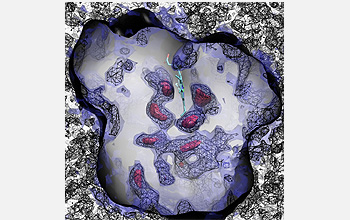Fact Sheet
Cyber-enabled Discovery and Innovation
February 5, 2007
This material is available primarily for archival purposes. Telephone numbers or other contact information may be out of date; please see current contact information at media contacts.
America's preeminence in information technology is widely recognized as essential to our economic competitiveness. The infusion of computation into science and engineering has revolutionized how research is carried out and applied. Once used by only a handful of elite researchers on select problems, advanced computing has now become essential to future progress and exploration. Coupled with continuing improvements in microprocessor speeds, converging advances in networking, software, visualization, data systems and collaboration platforms are changing the way research and education are accomplished.
Still, the broad and complex questions posed by 21st Century inquiry require access to new information technology capabilities, such as distributed wired and wireless observing network complexes, and sophisticated simulation tools that permit exploration of phenomena that can never be observed or replicated by experiment. New concepts and tools are needed to address the challenges posed by a world of petascale computers grinding away at 1 quadrillion operations per second, massive data flows and databases, and an economy dependent on digitally enabled activity.
In fiscal year (FY) 2008, the National Science Foundation (NSF) will begin the Cyber-enabled Discovery and Innovation (CDI) initiative to explore radically new concepts, approaches and tools at the intersection of computational and physical or biological worlds. For four decades, NSF has provided leadership in the scientific revolution made possible by information technology. Through investments ranging from supercomputing centers and the Internet to software and algorithm development, NSF-supported information technology has stimulated scientific breakthroughs across all science and engineering fields.
CDI includes five themes:
- Knowledge extraction. Knowledge extraction encompasses a variety of techniques-such as data mining, visualization and using basic concepts from computation, geometry and topology that help investigators find what is most important in the nearly infinite amounts of data from sensors, telescopes, satellites, the Internet and surveys. Combining underlying concepts with different types of data from multiple sources, high-bandwidth communications, and tera- to petascale computation power, scientists and engineers can make sense of today's massive volumes of data.
- Interacting elements. Analyzing the flow of electricity or information across the power grid or Internet, describing protein folding and unfolding, and finding principles for scaling from the quantum to the nano to the macro scales, require scientists and engineers to understand interacting systems. Such systems--ranging from atomic particles to galaxies and from computer networks to societies--are at the heart of many science and engineering challenges, and their understanding and control are major sources of innovation. A large number of interacting elements, random interactions and aggregate or emergent phenomena are key factors in such systems. CDI will improve our ability to predict and deduce interactions in complex systems to better understand, design and control them.
- Computational experimentation. Computational experimentation allows insight into complex, real-world systems such as hurricanes, nerve synapse activity, or the Big Bang, by enabling the creation of a virtual description. Simulation and other dynamic modeling techniques allow us to experiment with complex systems in ways that would be unimaginable in the real world. It also lets us guide real-world operations and experimentation in cases that have potential for unforeseen or extreme events. CDI will provide new modeling techniques ranging from mathematical formulations to multiscale simulation techniques.
- Virtual environments. Virtual environments are important mechanisms to enhance discovery, learning and innovation. They permit collaboration among diverse populations spread across geographic distances and at different times. Scheduling and operation of distributed facilities and sensor arrays, data extraction and analysis, international, real-time comparisons of global climate models, and injecting discovery and innovative environments into learning and training all use virtual environments. CDI will develop new techniques for building and utilizing virtual environments, especially in the context of cyberinfrastructure.
- Educating researchers and students in computational discovery. The promise of these new technologies, as well as their diffusion into other segments of the economy, will not be realized without education. CDI will integrate computational discovery techniques into the basic education of all scientists and engineers as well as development of new techniques for using computational discovery in all areas. Special focus will be placed on using virtual environments and cyberinfrastructure at all education levels. By enhancing human cognition and perception addressing complexity, computational tools provide an essential component to workforce development.
In FY 2008, NSF will begin CDI as a 5-year initiative with first-year funding of $52 million and a suggested growth of $50 million per year for 5 years.
-NSF-
Media Contacts
Leslie Fink, NSF, (703) 292-5395, email: lfink@nsf.gov
The U.S. National Science Foundation propels the nation forward by advancing fundamental research in all fields of science and engineering. NSF supports research and people by providing facilities, instruments and funding to support their ingenuity and sustain the U.S. as a global leader in research and innovation. With a fiscal year 2023 budget of $9.5 billion, NSF funds reach all 50 states through grants to nearly 2,000 colleges, universities and institutions. Each year, NSF receives more than 40,000 competitive proposals and makes about 11,000 new awards. Those awards include support for cooperative research with industry, Arctic and Antarctic research and operations, and U.S. participation in international scientific efforts.
Connect with us online
NSF website: nsf.gov
NSF News: nsf.gov/news
For News Media: nsf.gov/news/newsroom
Statistics: nsf.gov/statistics/
Awards database: nsf.gov/awardsearch/
Follow us on social
Twitter: twitter.com/NSF
Facebook: facebook.com/US.NSF
Instagram: instagram.com/nsfgov

